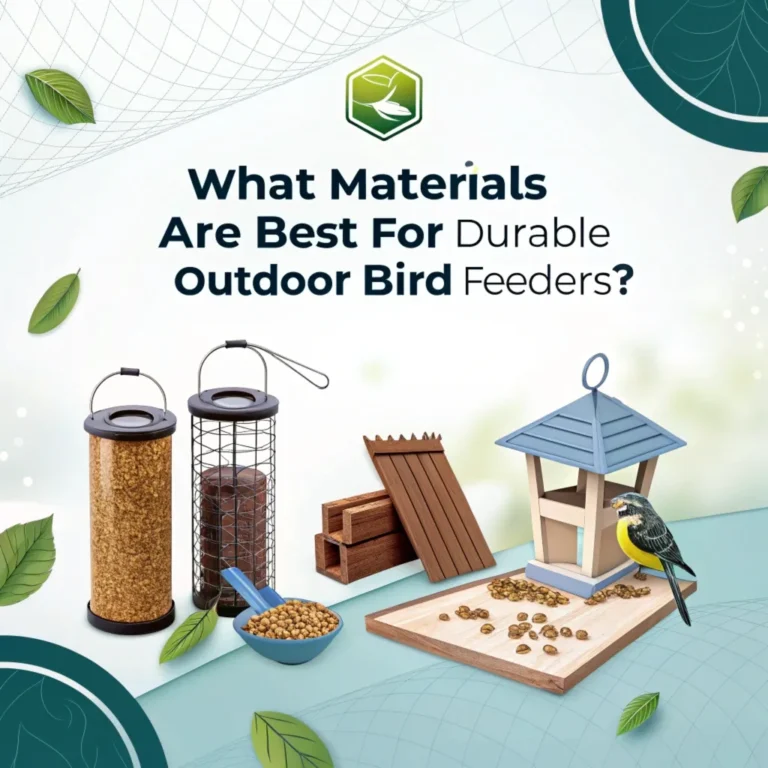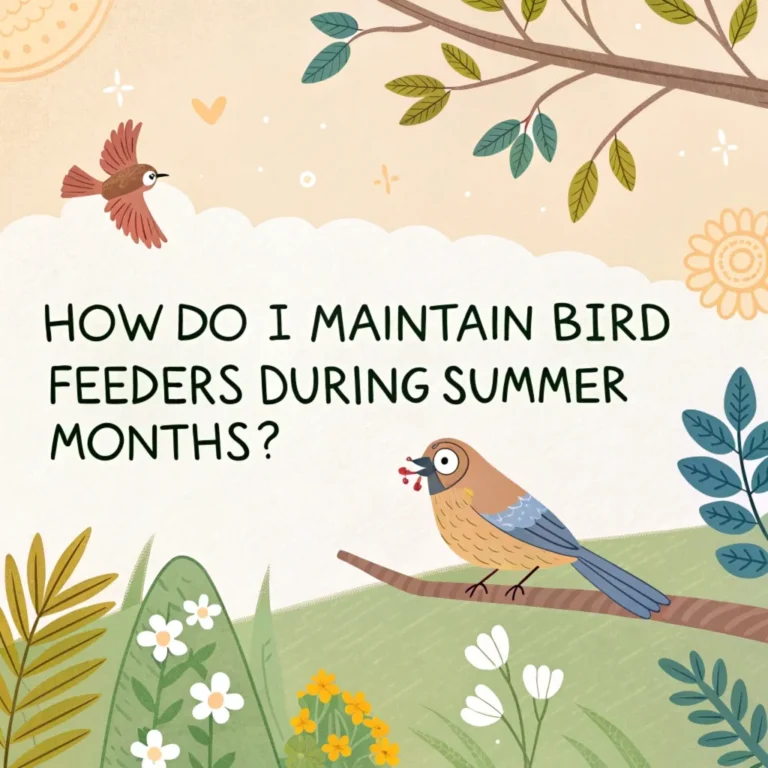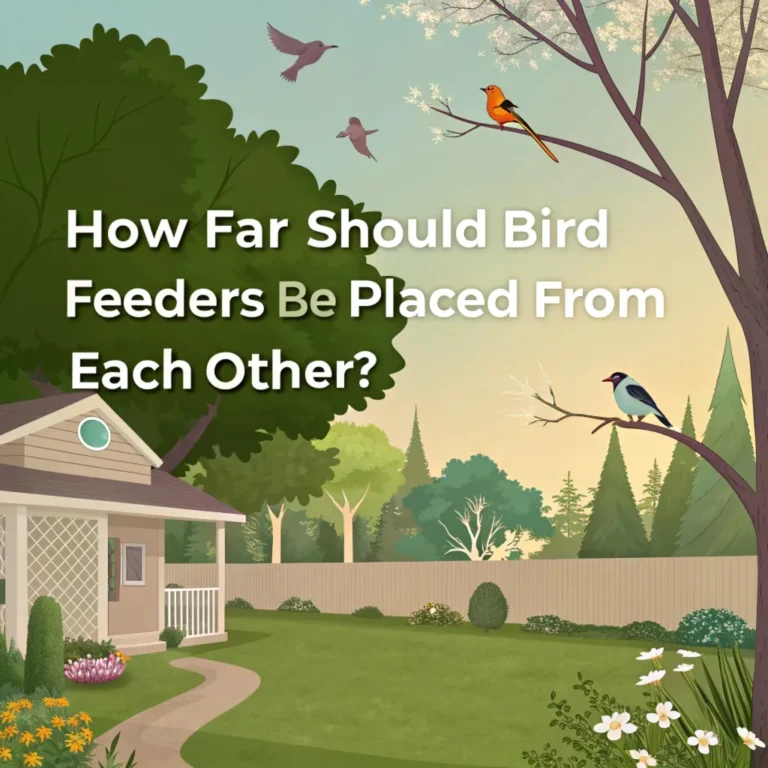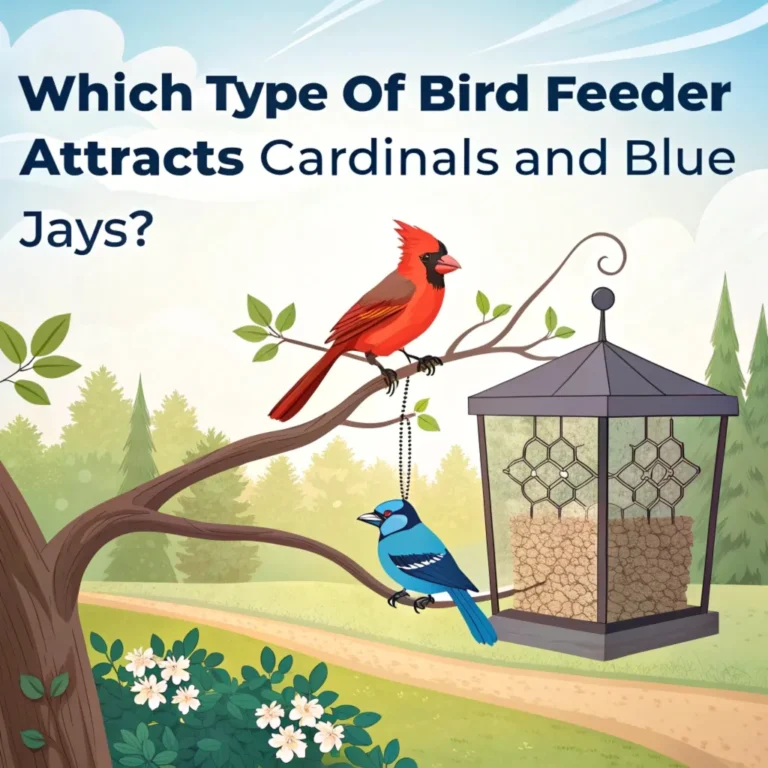How Deep Should a Platform Bird Feeder Be for Optimal Feeding?
Platform bird feeders offer an excellent way to attract a variety of birds to your yard.
The depth of these feeders plays a crucial role in their effectiveness.
This post explores the optimal depth for platform bird feeders to ensure the best feeding experience for your feathered visitors.

Key Takeaways
- Platform feeder depth: Typically 1 to 2 inches deep for optimal feeding
- Drainage: Essential for preventing seed spoilage and mold growth
- Feeder size: Varies based on bird species you want to attract
- Material: Durable materials like metal or weather-resistant wood are best
- Placement: 5 to 6 feet above ground for most birds
- Cleaning: Regular cleaning is crucial for bird health
- Seed types: Different seeds attract different bird species
- Weather considerations: Depth affects seed protection from elements
- Accessibility: Shallow depth allows easy access for various bird sizes
- Maintenance: Proper depth simplifies cleaning and refilling
Understanding Platform Bird Feeders
Platform bird feeders consist of a flat surface with short walls to hold seeds. These feeders attract a wide range of bird species due to their open design.
The depth of the feeder affects how much seed it can hold and how easily birds can access the food.
Platform feeders offer a versatile feeding solution for backyard bird enthusiasts. Their open design mimics natural feeding grounds, making them attractive to a diverse array of bird species.
From small finches to larger cardinals and jays, these feeders accommodate birds of various sizes and feeding habits.
The simplicity of platform feeders makes them an excellent choice for both novice and experienced bird watchers. Their flat surface allows for easy seed distribution and cleaning, ensuring a hygienic feeding environment for your feathered visitors.
Optimal Depth for Platform Feeders
The ideal depth for a platform bird feeder is typically 1 to 2 inches. This depth provides several benefits:
- Allows easy access for birds of various sizes
- Holds enough seed for multiple birds to feed
- Prevents excessive seed accumulation and spoilage
- Enables birds to see potential threats while feeding
The optimal depth of a platform feeder is crucial for creating a comfortable and safe feeding environment.
A depth of 1 to 2 inches strikes the perfect balance between seed capacity and accessibility. This shallow design allows birds to easily reach the seeds while maintaining a clear view of their surroundings, enhancing their sense of security while feeding.
By keeping the depth within this range, you ensure that smaller birds can access the food without struggling, while larger birds can still comfortably perch on the edges.
This inclusive design promotes a diverse bird population in your yard, enriching your birdwatching experience.
Importance of Proper Drainage

A well-designed platform feeder should have a metal mesh base that allows water to drain. This feature is crucial because:
- It prevents seeds from becoming soggy
- Reduces the risk of mold growth
- Keeps the feeding area clean and hygienic
Proper drainage is a critical aspect of platform feeder design that often goes overlooked. Without adequate drainage, rainwater and moisture can accumulate, leading to seed spoilage and potentially harmful conditions for birds.
A metal mesh base allows water to pass through while retaining seeds, ensuring a dry and healthy feeding environment.
Good drainage also helps maintain the structural integrity of the feeder, preventing wood rot in wooden feeders and rust in metal ones. This extends the life of your feeder and provides a safer, more hygienic space for birds to enjoy their meals.
Feeder Size Considerations
While depth is important, the overall size of the feeder matters too. Consider these factors:
- Larger platforms accommodate more birds simultaneously
- Smaller feeders are suitable for limited spaces or specific bird species
- Balance feeder size with the frequency of refilling
The size of your platform feeder can significantly impact the variety and number of birds it attracts.
Larger feeders provide more space for multiple birds to feed simultaneously, encouraging social feeding behaviors and attracting a wider range of species.
However, they also require more frequent cleaning and refilling to maintain freshness.
Smaller feeders, while limiting the number of birds that can feed at once, can be ideal for targeted feeding of specific species or for use in confined spaces.
They also allow for easier monitoring of seed consumption and bird activity. Consider your space, the local bird population, and your maintenance preferences when selecting the appropriate feeder size.
Material Selection for Durability

Choose durable materials for your platform feeder:
- Metal feeders resist wear and tear
- Weather-resistant wood offers a natural look
- Avoid plastics that may degrade quickly in sunlight
The choice of material for your platform feeder is crucial for its longevity and effectiveness. Metal feeders, particularly those made of galvanized steel or aluminum, offer excellent durability and resistance to the elements. They’re easy to clean and can withstand pecking and scratching from birds.
Cedar and other weather-resistant woods provide a more natural aesthetic that blends well with outdoor environments. These materials can be treated with non-toxic sealants to enhance their durability while remaining safe for birds.
Avoid using treated lumber or woods with harmful chemicals that could leach into the seeds.
Optimal Placement for Bird Safety
Place your platform feeder at the right height:
- 5 to 6 feet above ground is ideal for most birds
- Higher placement deters ground predators
- Ensure clear flight paths for birds approaching the feeder
The placement of your platform feeder plays a crucial role in attracting birds while ensuring their safety.
Positioning the feeder at 5 to 6 feet above ground provides an optimal balance between accessibility and protection from ground-based predators like cats or small mammals.
Consider the surrounding environment when placing your feeder. Ensure there are nearby trees or shrubs that offer quick escape routes for birds if they feel threatened.
However, avoid placing the feeder too close to dense foliage where predators might hide. A clear line of sight around the feeder allows birds to feel secure while feeding.
Importance of Regular Cleaning
Maintain a clean feeding environment:
- Brush off debris daily
- Scrub the feeder weekly with mild disinfectant
- Allow the feeder to dry completely before refilling
Regular cleaning of your platform feeder is essential for the health and well-being of visiting birds. A clean feeder prevents the spread of diseases and ensures that the seeds remain fresh and appealing.
Daily brushing removes droppings, seed husks, and other debris that can accumulate quickly on the open surface of a platform feeder.
Weekly deep cleaning with a mild disinfectant solution helps eliminate any bacteria or mold that might have started to grow.
After cleaning, it’s crucial to let the feeder dry completely before refilling to prevent moisture from contaminating fresh seeds. This cleaning routine not only maintains a healthy feeding environment but also extends the life of your feeder.
Seed Selection for Different Birds
Choose seeds based on the birds you want to attract:
- Black-oil sunflower seeds attract a wide variety of birds
- Nyjer seeds are favored by finches
- Millet attracts ground-feeding birds
The type of seeds you offer in your platform feeder can significantly influence the species of birds that visit your yard.
Black-oil sunflower seeds are a popular choice due to their high oil content and thin shells, making them attractive and easy to eat for many bird species, including cardinals, chickadees, and nuthatches.
Nyjer seeds, with their small size and high fat content, are particularly appealing to finches and other small birds.
Millet is excellent for attracting ground-feeding birds like doves and sparrows. Consider offering a mix of seeds to attract a diverse range of bird species to your feeder.
Weather Considerations and Feeder Depth
The depth of your feeder affects how well it protects seeds from weather:
- Deeper feeders offer more protection from rain and snow
- Shallower feeders may require more frequent refilling in bad weather
- Consider adding a roof to protect seeds in rainy climates
Weather conditions play a significant role in the effectiveness of your platform feeder. While the ideal depth of 1 to 2 inches is generally suitable, you may need to adapt to your local climate.
In areas with frequent rain or snow, a slightly deeper feeder can help protect seeds from moisture, preventing them from becoming soggy or freezing.
However, deeper feeders can make it difficult for smaller birds to access the seeds at the bottom. A potential solution is to add a simple roof or overhang to your platform feeder.
This addition can shield the seeds from direct precipitation while maintaining the shallow depth that allows easy access for all bird sizes.
Accessibility for Various Bird Species
A shallow depth ensures accessibility:
- Small birds can easily reach seeds
- Larger birds can comfortably perch on the edges
- Ground-feeding birds adapt well to platform feeders
The accessibility of your platform feeder is crucial for attracting a diverse range of bird species. A shallow depth of 1 to 2 inches ensures that birds of all sizes can comfortably access the seeds.
Small birds like finches and chickadees can easily hop onto the platform and reach the food, while larger birds such as jays and woodpeckers can perch on the edges to feed.
Platform feeders are particularly appealing to ground-feeding birds like doves and juncos, as they mimic natural feeding conditions. The open design allows these birds to comfortably feed in a way that’s familiar to them, making your feeder an attractive option for a wide variety of species.
Maintenance and Refilling Ease
The right depth simplifies feeder maintenance:
- Easy to clean thoroughly
- Quick to refill without spilling
- Allows visual inspection of seed quality
Proper maintenance of your platform feeder is essential for the health of visiting birds and the longevity of the feeder itself.
A depth of 1 to 2 inches makes the feeder easy to clean thoroughly, allowing you to remove all debris and old seeds efficiently.
This shallow depth also makes it simple to visually inspect the seed quality, ensuring you’re always providing fresh, uncontaminated food.
Refilling a shallow platform feeder is quick and straightforward, reducing the chances of spilling seeds.
This ease of maintenance encourages more frequent cleaning and refilling, which in turn promotes a healthier feeding environment for birds and a more enjoyable birdwatching experience for you.
Balancing Depth and Capacity
Find the right balance between depth and seed capacity:
- Deeper feeders hold more seed but may be less accessible
- Shallower feeders require more frequent refilling but are more bird-friendly
Balancing depth and capacity is crucial when designing or choosing a platform feeder. While deeper feeders can hold more seeds, potentially reducing the frequency of refills, they may pose accessibility issues for smaller birds.
Conversely, shallower feeders are more accessible to a wider range of bird species but require more frequent refilling.
The ideal solution often lies in finding a middle ground. A depth of 1 to 2 inches typically provides the best balance, offering enough capacity to feed multiple birds while remaining accessible to species of various sizes.
This balance ensures that your feeder remains attractive to a diverse bird population while not becoming overly burdensome in terms of maintenance.
Adapting to Your Local Bird Population
Observe the birds in your area:
- Adjust feeder depth based on the most common visitors
- Experiment with different depths to see what works best
Understanding your local bird population is key to optimizing your platform feeder’s effectiveness. Take time to observe the types of birds that frequent your yard and their feeding habits.
If you notice predominantly smaller birds, a shallower feeder might be more appropriate. For areas with larger birds, a slightly deeper feeder could be beneficial.
Don’t hesitate to experiment with different depths within the 1 to 2 inch range. You might find that certain depths attract a more diverse range of species or encourage longer feeding sessions.
Keep a log of your observations to help determine the most effective depth for your specific location and bird population.
Seasonal Adjustments to Feeder Depth
Consider changing your approach with the seasons:
- Deeper in winter to hold more food during scarce times
- Shallower in summer when natural food is more abundant
Seasonal changes can significantly impact bird feeding habits and the effectiveness of your platform feeder. During winter months, when natural food sources are scarce, birds rely more heavily on feeders.
A slightly deeper feeder during this time can hold more seeds, providing a reliable food source during harsh weather conditions.
In contrast, summer brings an abundance of natural food options for birds. During this season, a shallower feeder depth can be more appropriate.
It encourages birds to supplement their diet with feeder seeds rather than relying on them entirely, promoting a more balanced and natural feeding pattern.
Combining Platform Feeders with Other Types
Use platform feeders alongside other feeder types:
- Diversify feeding options to attract more bird species
- Create a feeding station with multiple feeder styles
Incorporating a variety of feeder types in your yard can significantly enhance your birdwatching experience.
While platform feeders are excellent for attracting a wide range of species, combining them with other feeder styles can create a more diverse and attractive feeding station for birds.
Consider adding tube feeders for seed-loving birds, nectar feeders for hummingbirds, and suet feeders for woodpeckers and other insect-eating birds.
This variety not only attracts different species but also reduces competition at any single feeder, allowing more birds to feed comfortably and safely in your yard.
FAQs
How often should I clean my platform bird feeder?
Clean your platform bird feeder weekly with a mild disinfectant solution. Brush off debris daily and allow the feeder to dry completely before refilling.
Can I use a platform feeder to feed squirrels?
While platform feeders can attract squirrels, it’s best to use separate feeders for squirrels to prevent competition with birds and maintain cleaner feeding areas for your avian visitors.
What’s the best material for a platform bird feeder?
Metal or weather-resistant wood are ideal materials for platform bird feeders. They offer durability and resist damage from weather and wildlife.
How high should I place my platform bird feeder?
Place your platform bird feeder 5 to 6 feet above the ground. This height provides good visibility for birds while feeding and helps protect them from ground predators.
Can I put fruit on a platform bird feeder?
Yes, you can offer fruits like apple slices or berries on a platform feeder. This can attract fruit-eating birds like orioles and tanagers. Remember to remove any uneaten fruit promptly to prevent spoilage.

Luna is the passionate founder and author of Birds and You, a website dedicated to sharing her love for birds with fellow enthusiasts. Through her engaging articles and guides, she aims to educate and inspire others to explore the fascinating world of birds. When she’s not writing, you can find Luna observing birds in their natural habitats or sharing beautiful bird photography on Pinterest. Join her on this journey to celebrate and protect our feathered friends!







